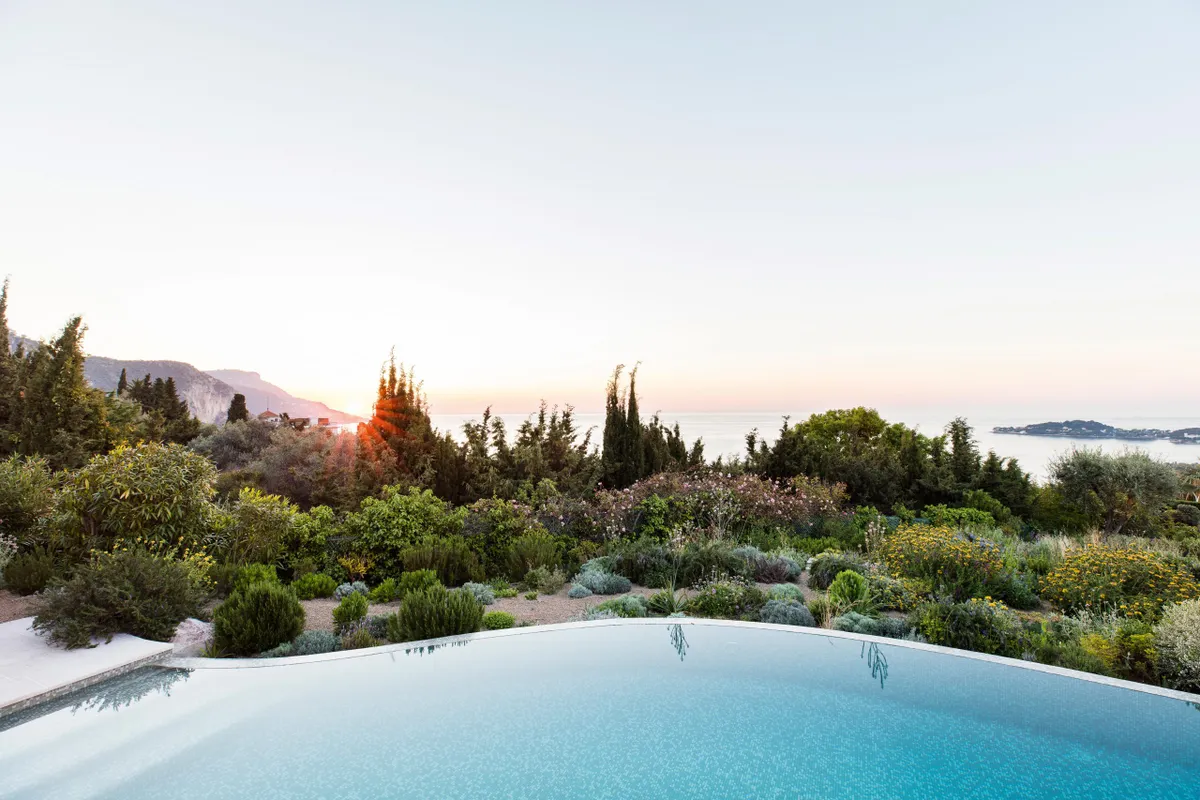James Basson is a designer best known to British garden-style watchers as the winner of the best in show award at the RHS Chelsea Flower Show in 2017. That is because nearly all of his work to date has been achieved on the French Riviera, where he is based. James and his wife, Helen, moved to the area and set up a practice in 2000, and have very much made it their home. Neither has French lineage, though James spent time during his school holidays in Monaco, where his family had moved when he was 13. Helen plays a key role in the practice, Scape Design, and is equally credited for the work, though it is James who takes the creative and horticultural lead.
At a small private garden in the foothills of the Alpes-Maritime overlooking the coast at Villefranche-sur-Mer near Nice, James has been honing, since 2009, a planting system that is suited to the climate, and which needs no irrigation. He is realistic about its limitations: “In the end you just can’t have flowers if you’re not going to water.” Instead, he has formulated a look inspired by the botanical discoveries of his mentor, Olivier Filippi, the French nurseryman based near Montpellier. “Olivier taught me how to plant a landscape,” James says. “My technical approach is based on the model of his nursery. It means that gardens in this climate can exist for more than just three months of the year.” This is a philosophy of gardening that embraces the idea that the garden will ‘dry out’ in summer. Read more about James' dry garden below.
Don't miss our piece on the best drought tolerant plants.

James Basson’s stylised garrigue plantings include the aromatic, white-flowered Coleonema album (foreground) and behind it, Phlomis cypria (right) and Phlomis x cytherea (left). Tall, branched Asphodelus aestivus rear up beyond, for height variation.

The garden’s boundaries are blurred to create the impression of extra space. Rambler roses have been planted on the fence line just beyond the pool edge, with pines and olives beyond.

In the lower part of the garden, at the foot of the terraces, the components of James’s carefully balanced planting scheme – all set in a gravel mulch – can be appreciated. Pink-flowered Cistus x purpureus has a dominant presence in early summer, though James notes that “then they dissolve back into the landscape to provide a muted tone to other plants, and are ever present on the air in the summer as the heat releases the oils on their leaves”. The architectural quality of the evergreen leaves of Iris unguicularis is also valued. A line of rosemary, now known as Salvia rosmarinus, forms a long, snaking ‘hedge’ across the garden, creating a subtle sense of structure. It also provides the darkest leaf tone, against which lighter colours, such as the pale-toned Ballota pseudodictamnus, can be placed. This sub-shrub says James is “a brilliant plant, quick to establish and relatively long lived – a useful plant to create a quick dominant vegetation, though in wetter climates it may not live as long or grow as quickly”. It also stands out against the crinkly leaves of clary sage, Salvia sclarea, that presage its flowers, and which are especially appreciated when dried and backlit by the sun. Hidden away next to this is Origanum majorana var. tenuifolium, which is useful for its late flowers. Soft yellow tones are contributed by Salvia greggii ‘Alba’, while there is dusty purple from Lavandula x heterophylla ‘African Pride’, a resilient cultivar in James’s experience.

The terrace walls follow the natural contours and lead the eye on to the coastal vista. The upper terraces are dominated by the acid tones of Euphorbia rigida with clumps of Iris unguicularis. Lower down, a hedge of rosemary creates structure among mound-forming plants, such as Lavandula x heterophylla ‘African Pride’ and Salvia sclarea.

An olive tree provides welcome shade in the lower part of the garden, with stepping stones carving a path through plantings that include Cistus salvifolius (lower right), Anisodontea malvastroides (the shrub with small, pink mallow flowers to the left of the path) and (background, right) the tree spurge, Euphorbia dendroides.
Find out more about Scape Design’s work at scapedesign.com/en
Don't miss our piece on the best drought tolerant plants from James' garden designs.

